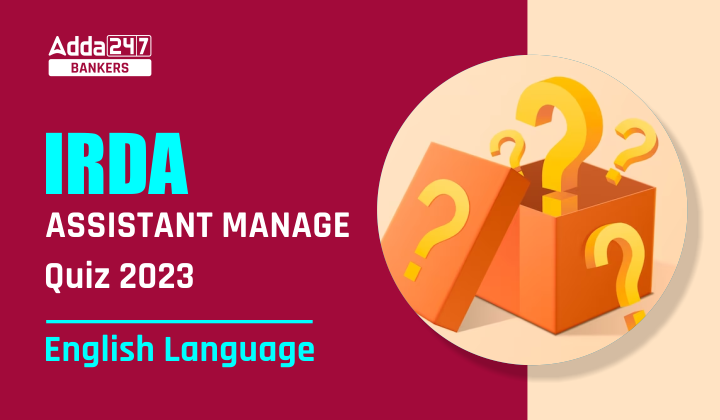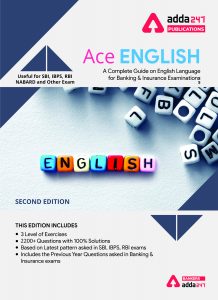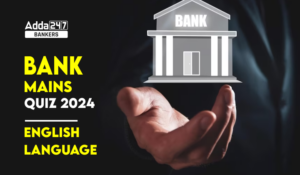Directions (1-10): Read the following passage carefully and answer the questions given below it. Certain words are given in bold to help you locate them while answering some of the questions.
Slightly overshadowed by the news of rising fuel prices was a recent report about the Delhi Metro being the second most unaffordable in the world among metro systems that charge less than half a US dollar for a trip, with the average commuter paying 14% of their income to travel by it. A study by the Centre for Science and Environment recommended that both the state and Central governments adopt strategies to increase public transit ridership, and enable fiscal solutions to keep it affordable.
Meanwhile, opposition parties called a bandh recently to demand that the government take steps to reduce fuel prices. But is this really the best solution? In major urban centers, at least, a more sustainable solution would involve keeping petrol prices high and investing the tax revenue generated into funding public transit and keeping its fares affordable. This is now possible by law, thanks to a change brought about in the 2018 Union budget.
The price of petrol comprises substantially of taxes—only about 50% of the market price is made up by the cost of production and refining. Besides excise duty levied by both central and state governments, the former has, for the last two decades, levied a road cess on every litre of petrol (and diesel) as additional excise duty, towards the Central Road Fund. Established by an Act of Parliament in 2000, the proceeds of this fund were, until 2018, used for road construction, including programmes such as the National Highways Development Project (NHDP) and the Pradhan Mantri Gram Sadak Yojana (PMGSY) for construction of rural roads. The cess, originally 1 per litre, has increased to 8 per litre in the 2018 Union budget, and been renamed as the infrastructure cess. The 2018 Finance Act also renamed the fund as the Central Road and Infrastructure Fund, expanding its ambit to cover other kinds of infrastructure beyond roads. Among the new categories for which the fund is to be used is urban public transport. In 2018–19, the fund is expected to receive over 1.13 trillion from the infrastructure cess. Delhi offers an interesting example of how this could be used to benefit citizens and contribute to offsetting carbon emissions from petrol (and diesel) cars.
In 2016, the Delhi Metro’s fourth fare fixation committee (FFC) submitted its report. It analyzed the Delhi Metro Rail Corporation’s (DMRC’s) finances on the basis of the existing fare structure, and concluded that the company would face increasing losses. Therefore, it proposed a fare hike of 100%. This was implemented in two phases—in May and October2017—as the FFC itself noted that 30% of Metro passengers earned less than ₹20,000 a month and a single steep hike would adversely affect them. Nevertheless, it resulted in an immediate drop in ridership by 15%, while the DMRC is set to project an operational profit from 2018-19. One might argue that revenues increased, but surely the purpose of public transit is not to generate revenue but transport the largest number of people at the least cost—to them, society and the environment. What has instead resulted is an “operationally profitable” public transit system that serves fewer people at higher cost. With rising fuel prices, the cost of private transport (after the fare hikes, operating a two-wheeler on many routes became cheaper than using the Metro) has also increased.
The government has two ways of resolving this unsustainable situation: (1) reduce taxes on fuel, making private transport cheaper; (2) reduce fares, making public transit cheaper. The second is obviously the more environment-friendly and sustainable solution for the city and its residents, beset as it is with pollution, traffic congestion and high vehicle ownership. A reduction of fares even to May 2017 levels will result in a drop of 25–33% for most journeys. At these fares, the overall losses to DMRC (after accounting for operational expenses, depreciation, interest and loan repayments) will be in the range of under 600 crore annually, which is less than the cess revenue generated in Delhi through petrol sales alone. Delhi can thus afford to reduce its Metro fares using just the revenue from petrol sales. Further, with the increased rate of cess from 2018–19, this revenue is likely to rise. The surplus, along with the revenue from diesel, can be used to make investments in other public transport providers such as the Delhi Transport Corporation and the Delhi Integrated Multi-Modal Transit System, as well as improvements in pedestrian infrastructure—especially in the vicinity of Metro stations and bus stops to ensure seamless and improved connectivity for all citizens. The Central government should, therefore, begin treating the infrastructure cess as a carbon tax in urban areas and ensure that the revenue accruing to the Central Road and Infrastructure Fund from urban areas is invested in urban public transport. Whether car and two-wheeler owners will be incentivized to reduce using their vehicles because of this is difficult to say. Even with no change in private vehicle usage, the result will still be an affordable and improved public transit system for everyone.
Q1. According to the passage, what is described as the best solution to increase public transit ridership instead of reducing the fuel prices?
(a) Using chemically stored electricity like batteries and fuel cells, non-fossil methane and other biomass sources.
(b) To expand other kinds of infrastructure beyond roads from the revenue generated by increasing the hike in private transport.
(c)Investing tax revenue, generated by keeping the petrol prices high, into funding public transit.
(d) Bringing a great hike in the prices of private transport.
(e) None of these.
Q2. What other categories in reference to infra development were covered by the Central Road and Infrastructure Fund under the Finance Act 2018?
(a) Development of urban public transport system
(b) Build Infrastructure such as roads.
(c) The fund is used in improving connectivity of ports and airports.
(d) Acquisition of land thereby preventing deforestation.
(e) To cater the increasing needs of growing economy.
Q3. Why making public transit cheaper is a preferred method over reducing taxes on fuel?
(a) As high revenue generated from petrol or diesel can be used to improve DTC and other services.
(b) It is an environment friendly solution with trouble free high vehicle ownership issues.
(c) As this would help in reducing traffic congestion.
(d) Both (a) and (c)
(e) All (a), (b) and (c)
Q4. According to the passage, out of the following which option bolsters the fact that “Delhi can afford to reduce its Metro fares using just the revenue from petrol sales?”
(a) Replacement of various assets such as Rolling Stock which have a life of 30 years.
(b)The overall losses to DMRC will be in the range of under 600 crore annually, which is less than the cess revenue generated in Delhi through petrol sales alone.
(c) Depreciation, interest and loan repayments of DMRC will be in the range of under 600 crore annually, which is more than the cess revenue generated in Delhi through petrol sales alone.
(d) Both (b) and (c).
(e) Both (a) and (b).
Q5. Which of the statements among the given options is definitely false according to the given passage?
(a) Both the State and Centre must adopt strategies to increase public transit ridership.
(b) In 2016, FCC analyzed DMRC’s finances and concluded that the company would face increasing losses.
(c)With rising fuel prices, the cost of private transport at least in some cities has also decreased.
(d) Central Road and Infrastructure Fund expand its ambit to cover other kinds of infrastructure beyond roads.
(e)In 2018–19, the Central and Infrastructure Road fund is expected to receive over Rs.1.13 trillion from the infrastructure cess.
Q6. Choose the word which is most nearly the SAME in meaning as the word printed in bold as used in the passage.
AMBIT
(a)Restrict
(b)Constancy
(c)Periphery
(d)Affinity
(e)Dissipated
Q7. Choose the word which is most nearly the SAME in meaning as the word printed in bold as used in the passage.
STEEP
(a)Frugal
(b)Excessive
(c)Affordable
(d)Moderate
(e)Prudent
Q8. Choose the word which is most nearly the SAME in meaning as the word printed in bold as used in the passage.
BESET
(a)Torment
(b)Defend
(c)Provide
(d)Shelter
(e)Justify
Q9. Choose the word which is the OPPOSITE in meaning as the word printed in bold as used in the passage.
DEPRECIATION
(a)Devaluation
(b)Slump
(c)Plunge
(d)Tumble
(e)Surge
Q10. Choose the word which is the OPPOSITE in meaning as the word printed in bold as used in the passage.
ACCRUING
(a)Augmenting
(b)Accumulating
(c)Amassing
(d)Dispersing
(e)Reckoning
Solutions
S1. Ans. (c)
Sol. In the first paragraph, the author has described about how the opposition parties think that the best solution is to reduce the fuel prices. But the most sustainable solution is keeping petrol prices high and investing the tax revenue generated into funding public transit and keeping its fares affordable. Furthermore this solution is possible by a change brought in about in the 2018 Union budget.
S2. Ans. (a)
Sol. Option (a) is the most suitable option here. Refer to second paragraph where it is given that the 2018 Finance Act renamed the fund as the Central Road and Infrastructure Fund expanding its scope and boundaries to cover other kinds of infrastructure beyond roads. And the other category for which the fund is to be used is the urban public transport.
S3. Ans. (e)
Sol. Option (e) is the most appropriate choice here. The answer can be deduced from the fourth paragraph in which the first line of the paragraph itself says that the government has two ways of resolving this unsustainable situation. Reducing fares, making public transit cheaper is obviously the more environment-friendly and sustainable solution for the city and its residents, beset as it is with pollution, traffic congestion and high vehicle ownership. This is stated in the passage .Hence the answer.
S4. Ans. (b)
Sol. Option (b) is the correct choice here. For options (b) refer to fourth paragraph where it is stated that “At these fares, the overall losses to DMRC (after accounting for operational expenses, depreciation, interest and loan repayments) will be in the range of under 600 crore annually, which is less than the cess revenue generated in Delhi through petrol sales alone. Delhi can thus afford to reduce its Metro fares using just the revenue from petrol sales.”
S5. Ans. (c)
Sol. Among all of the given options, option (c) is the correct choice which is definitely false according to the given passage. For the conformity of the answer , refer to paragraph 3 where the statement is given as with rising fuel prices, the cost of private transport (after the fare hikes, operating a two-wheeler on many routes became cheaper than using the Metro) has also increased. Rest all of the options are completely true in context as well as relevance of the passage.
S6. Ans. (c)
Sol. Ambit means the scope, extent, or bounds of something.
Periphery means the outer limits or edge of an area or object.
Affinity means resemblance.
Constancy means consistency.
Dissipated means dispersed.
S7. Ans. (b)
Sol. Steep means (of a price or demand) not reasonable; excessive in accordance to the context of the paragraph.
Excessive means the same as steep.
Frugal means economical, sparing.
Prudent means acting with or showing care and thought for the future.
S8. Ans. (a)
Sol. Beset means (of a problem or difficulty) trouble (someone or something) persistently.
Torment means a cause of severe suffering.
Defend means resist an attack made on (someone or something); protect from harm or danger.
Shelter means shield.
Justify means show or prove to be right or reasonable.
S9. Ans. (e)
Sol. Depreciation means a reduction in the value of an asset over time, due in particular to wear and tear.
Surge means increase suddenly and powerfully. Thus, it is the antonym of the given word.
Devaluation means the reduction or underestimation of the worth or importance of something.
Slump means undergo a sudden severe or prolonged fall in price, value, or amount.
Plunge means fall suddenly and uncontrollably.
Tumble means fall suddenly, clumsily, or headlong.
S10. Ans. (d)
Sol. Accruing means accumulating or receiving (payments or benefits) over time.
Dispersing means distribute or spread over a wide area.
Augmenting means making (something) greater by adding to it; increase.
Amassing means gathering.
Reckoning means the action or process of calculating or estimating something.





 English Language Quiz For Bank Foundatio...
English Language Quiz For Bank Foundatio...
 English Language Quiz For Bank Mains Exa...
English Language Quiz For Bank Mains Exa...


